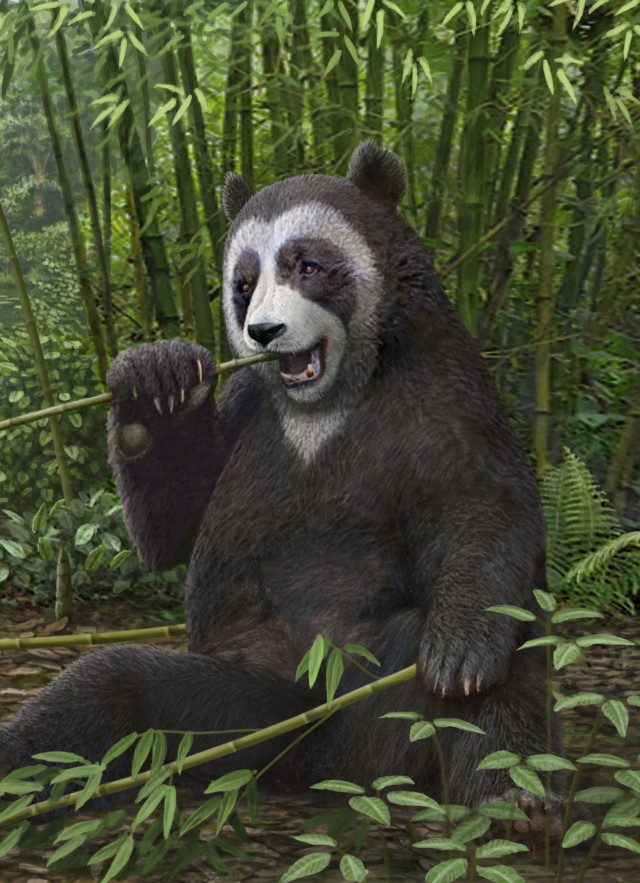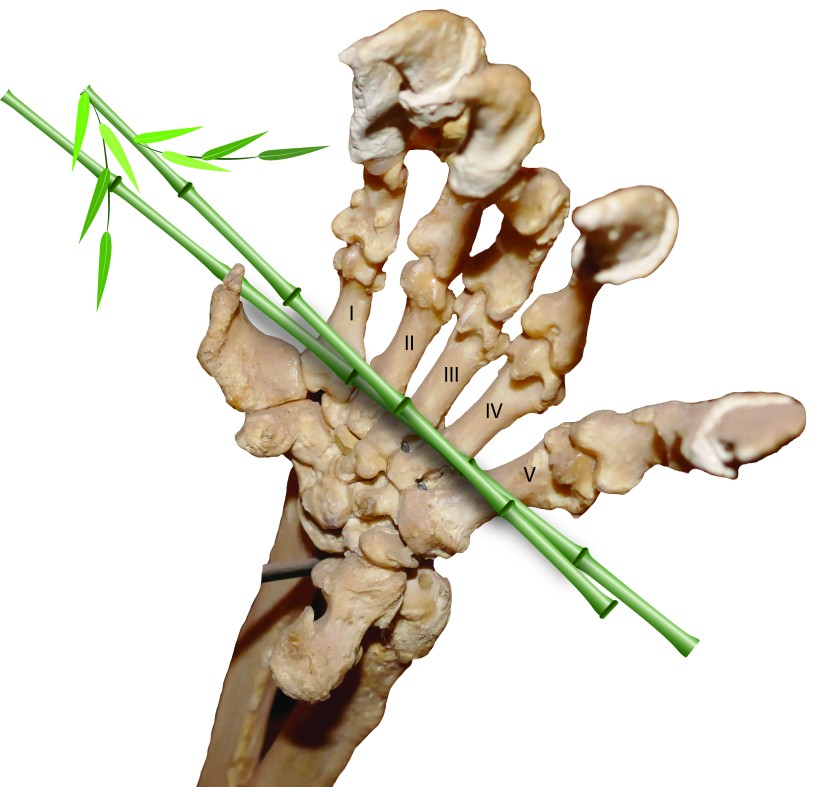Los Angeles, CA (June 30, 2022) — When is a thumb not a thumb? When it’s an elongated wrist bone of the giant panda used to grasp bamboo. Through its long evolutionary history, the panda’s hand has never developed a truly opposable thumb and instead evolved a thumb-like digit from a wrist bone, the radial sesamoid. This unique adaptation helps these bears survive entirely on bamboo despite being bears (members of the order Carnivora, or meat-eaters). In a new paper published in Scientific Reports, the Natural History Museum of Los Angeles County’s Curator of Vertebrate Paleontology Xiaoming Wang and colleagues report on the discovery of the earliest bamboo-eating ancestral panda to have this “thumb.” Surprisingly, it’s longer than its modern descendants.
While the celebrated false thumb in living giant pandas (Ailuropoda melanoleuca) has been known for more than 100 years, how this wrist bone evolved was not understood due to a near-total absence of fossil records. Uncovered at the Shuitangba site in the City of Zhaotong, Yunnan Province in south China and dating back 6–7 million years ago, a fossil false thumb from an ancestral giant panda, Ailurarctos, gives scientists a first look at the early use of this extra (sixth) digit–and the earliest evidence of a bamboo diet in ancestral pandas–helping us better understanding the evolution of this unique structure.
“Deep in the bamboo forest, giant pandas traded an omnivorous diet of meat and berries to quietly consuming bamboos, a plant plentiful in the subtropical forest but of low nutrient value,” says NHM Vertebrate Paleontology Curator Dr. Xiaoming Wang. “Tightly holding bamboo stems in order to crush them into bite sizes is perhaps the most crucial adaptation to consuming a prodigious quantity of bamboo.”
How to Walk and Chew Bamboo at the Same Time
This discovery could also help solve an enduring panda mystery: why are their false thumbs so seemingly underdeveloped? As an ancestor to modern pandas, Ailurarctos might be expected to have even less well-developed false“thumbs,” but the fossil Wang and his colleagues discovered revealed a longer false thumb with a straighter end than its modern descendants' shorter, hooked digit. So why did pandas’ false thumbs stop growing to achieve a longer digit?
“Panda’s false thumb must walk and ‘chew’,” says Wang. “Such a dual function serves as the limit on how big this ‘thumb’ can become.”
Wang and his colleagues think that modern panda’s shorter false thumbs are an evolutionary compromise between the need to manipulate bamboo and the need to walk. The hooked tip of a modern panda’s second thumb lets them manipulate bamboo while letting them carry their impressive weight to the next bamboo meal. After all, the “thumb” is doing double duty as the radial sesamoid–a bone in the animal’s wrist.
“Five to six million years should be enough time for the panda to develop longer false thumbs, but it seems that the evolutionary pressure of needing to travel and bear its weight kept the ‘thumb’ short–strong enough to be useful without being big enough to get in the way,” says Denise Su, associate professor at the School of Human Evolution and Social Change and research scientist at the Institute of Human Origins at Arizona State University, and co-leader of the project that recovered the panda specimens.
“Evolving from a carnivorous ancestor and becoming a pure bamboo-feeder, pandas must overcome many obstacles,” Wang says. “An opposable ‘thumb’ from a wrist bone may be the most amazing development against these hurdles.”
The authors of this article are affiliated with the Natural History Museum of Los Angeles County, Los Angeles, CA, USA; Institute of Vertebrate Paleontology and Paleoanthropology, Chinese Academy of Sciences, Beijing, China; Arizona State University, Tempe, Arizona, USA; Pennsylvania State University, University Park, Pennsylvania, USA; Kunming Institute of Zoology, Chinese Academy of Sciences, Kunming, Yunnan, China; Yunnan Institute of Cultural Relics and Archaeology, Kunming, Yunnan, China; Harvard University, Cambridge, Massachusetts, USA.
Funding was provided by the U.S.A. National Science Foundation, Yunnan Natural Science Foundation, National Natural Science Foundation of China, the Governments of Zhaotong and Zhaoyang, Institute of Vertebrate Paleontology and Paleoanthropology.
About the Natural History Museums of Los Angeles County
The Natural History Museums of Los Angeles County (NHMLAC) include the Natural History Museum in Exposition Park, La Brea Tar Pits in Hancock Park, and the William S. Hart Museum in Newhall. They operate under the collective vision to inspire wonder, discovery, and responsibility for our natural and cultural worlds. The museums hold one of the world’s most extensive and valuable collections of natural and cultural history—more than 35 million objects. Using these collections for groundbreaking scientific and historical research, the museums also incorporate them into on- and offsite nature and culture exploration in L.A. neighborhoods, and a slate of community science programs—creating indoor-outdoor visitor experiences that explore the past, present, and future. Visit NHMLAC.ORG for adventure, education, and entertainment opportunities.
About the Institute of Human Origins and School of Human Evolution and Social Change at Arizona State University
A research center of The College of Liberal Arts and Sciences at Arizona State University, the Institute of Human Origins (IHO) pursues an integrative strategy for research and discovery central to our founding mission—bridging social, earth, and life science approaches to the most important questions concerning the course, causes, and timing of events in the human career over deep time. IHO’s strategic vision reaches across the broadest range of transdisciplinary research to create novel approaches to the solution of pressing and newly emerging scientific questions relevant to our society. IHO also fosters an understanding of human evolution through innovative outreach programs that provide timely and accurate information for both educators and the public. IHO’s research scientists are faculty in the School of Human Evolution and Social Change, which seeks to understand the origins and implications of our human uniqueness—such as culture, cooperation and complexity. It combines the skills and perspectives of the largest anthropology and global health programs in the nation with smaller, hand-crafted ones in environmental social science, museum studies and applied math.
MEDIA CONTACT
For interviews and additional imagery, please contact Sally Márquez, smarquez@nhm.org.
Written by NHMLAC Digital Writer, Tyler Hayden.



